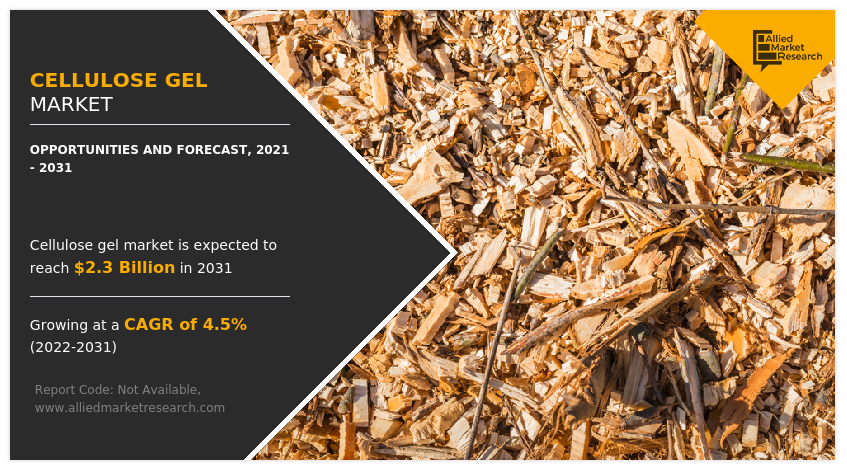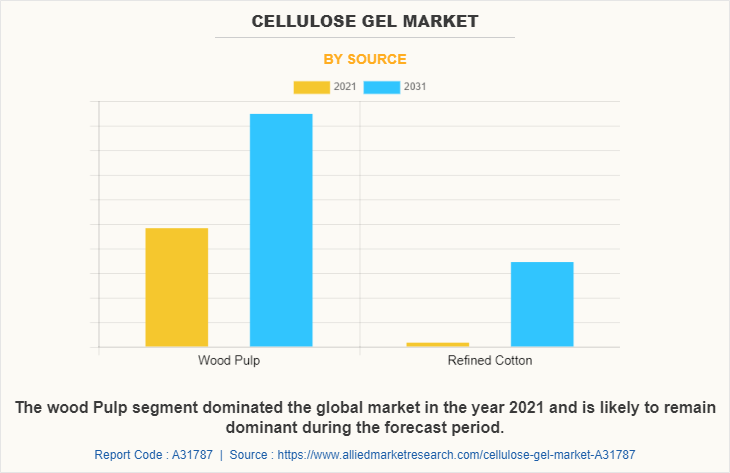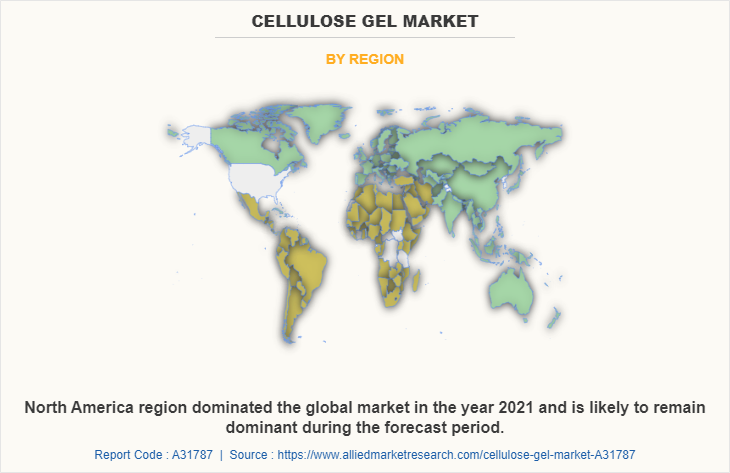Cellulose Gel Market Research, 2031
The global Cellulose Gel Market Size was valued at $1.5 billion in 2021, and is projected to reach $2.3 billion by 2031, growing at a CAGR of 4.5% from 2022 to 2031. Cellulose accounts for approximately 1.5‐¯×‐¯1012 tons of total annual biomass production. It mainly originated from wood, plants or agricultural residues, tunicate (animal), algae, and bacteria. The primary industrial use of cellulose has been the production of pulp and paper, although its use in novel materials, such as inorganic and polymeric composites, nan composites, hydrogels, and even electronics have been investigated.

Cellulose is one of the most versatile biopolymers found in nature. Its use is now transitioning from sustainability-focused development to providing technical solutions across a wide range of applications. This review paper describes the use of cellulose as reinforcement in bio composites and recent related advances in 3D printing technologies, including 4D (responsive/smart) printing and current/future applications. Relevant aspects such as the origin and intrinsic/structural properties of cellulose and cellulose/matrix interaction during processing are discussed. A particular focus is directed to identify opportunities for the development of new cellulose-based composites, formulation requirements for 3D/4D printing, and comprehension of the interplay between rheology, chemistry, and processing. Overall, new materials and technologies based on cellulose have shown promising results for real-life applications, opening new scientific development opportunities and a new generation of sustainable and advanced materials.
Essential raw materials for the production of cellulose are cotton and wood. According to the United States Department of Agriculture (USDA), there is a decline in the production of cotton in many major producing countries excluding China and Brazil owing to the change in climatic conditions in countries such as the U.S., India, Pakistan, and Australia. The U.S. witnessed a 12.1% decline in the production of cotton due to the severe storms in the country. Moreover, increase in pests have destroyed the cotton crop, which decreases the production of cotton. This also affects the production of cellulose gel.
Unique processing challenges are common with protein beverages. The higher the level of protein in a beverage, the more it is difficult to stabilize it during processing and keep it stable during its shelf-life. In addition, low pH parameters and high heat treatment are needed to produce RTD products, which adversely affects texture of the end product. The texture further impacts visual appearance of a beverage, which influences consumer acceptability and perception regarding the beverage. Therefore, cellulose gel is utilized in the beverages, to maximize the power of stabilized proteins and to bring smooth and stable beverage products that satisfy requirements of discerning consumers. Moreover, when proteins are properly stabilized in solutions, shaking of the product before use is not necessary. Therefore the demand for cellulose gel has witnessed growth in the market, owing to the stabilizing agent property. For instance, TABULOSE® is a plant-based stabilizer produced from purified wood pulp cellulose manufactured by Roquette, a leading producer of Cellulose Gel. TABULOSE® can be widely used in milk or plant-based RTD beverages. Also, the Ingredient House’s Tabulose SC-611 cellulose gel is said to perform well as a stabilizer and mouthfeel enhancer in ready-to-drink protein beverages in a standard shelf-life study. The product provides stability, creamy texture, and mouthfeel without separation or settling.
Cellulose gel is a derivative of cellulose that has been majorly used as a lubricant, emulsifier, stabilizer, and viscosity modifier to create various pharmaceutical dosages. The use of cellulose gel can be increased in the pharmaceutical industry as it can be used for healing wounds. Fabrication of poly (ethylene glycol) and cellulose gel blend films by casting solution is extensively used in wound care products. The CMC based wound care products blended with various polymers like poly (ethylene glycol) offer numerous benefits during wound care activities.
Products such as xanthan gum, pectin, and guar gum are the perfect substitutes for cellulose gel. Functionalities of xanthan gum, pectin, guar gum, and cellulose gel are similar as they have widespread application owing to the thickening, binding, suspending, emulsifying, and lubricating property. These also act as good stabilizing agents, viscosity modifiers, and coating agents. Therefore, they find wide applications in food & beverages, pharmaceutical, cosmetics & personal care, oil & refining, and house hold care industries. The presence of substitute products in the market affects the sales of cellulose gel, in turn limiting the market growth.
In addition, the essential raw materials for the production of cellulose are cotton and wood. According to the United States of Department of Agriculture (USDA), there is a decline in the production of cotton in many major producing countries excluding China and Brazil owing to the change in climatic condition in countries such as the U.S., India, Pakistan, and Australia. The U.S. experienced a 12.1% decline in the production of cotton due to the severe storms in the country. Moreover, increase in pest in crop has destroyed the cotton crop, which decreases the production of cotton. The change in climatic condition and increase in pests result in the reduction in the growth of cotton production. This also affects the production of cellulose gel.
The term “clean label” is consumer driven with no official definition, regulations, or guidelines from the Food and Drug Administration (FDA) or the U.S. Department of Agriculture. Clean label means food with a short list of ingredients that are natural, organic, and free from preservatives and functional additives, with no chemical or unrecognizable components. Major multinational companies including Cargill, Archer Daniels Midland, Corbion, Kerry, Ingredion, Tate & Lyle, Sensient Technologies, Frutarom, Koninklijke DSM, Chr. Hansen, and DuPont are participating in the development of clean label ingredients. Many smaller companies also approach this growing market with new ingredient offerings.
Cellulose gel is a binder, thickener, and also works as a stabilizer in various food. It is a thickening agent, which is made by reacting cellulose like cotton lint and wood pulp with an imitative of acetic acid. Its unabsorbent property promotes its usage in food labelling and primary packing applications. Its usage can be increased if it is used as clean label in real food as a natural, familiar ingredient, which is easy to identify and understand. The use of cellulose gel as a clean label is anticipated to foster its sale, and in turn boost the market growth.
The cellulose gel market is segmented into source, application, property, and region. On the basis of source, the market is categorized into wood pulp and refined cotton. By application, the market is classified into food & beverages, oil & refining, pharmaceutical, paint & textile, cosmetics & personal care, paper coating & household care, and others. By property, the Cellulose Gel industry is divided into thickening agent, stabilizer, binder, anti-repository agent, lubricator, emulsifier, and excipient. By region, the market is studied across North America, Europe, Asia-Pacific, and LAMEA.

On the basis of source, the market is bifurcated into wood pulp and refined cotton. The wood pulp has the dominating Cellulose Gel Market Share in 2021, and is anticipated to remain dominant during the Cellulose Gel Market Forecast period.

On the basis of application, the market is classified into food & beverages, oil & refining, pharmaceutical, paint & textile, cosmetics & personal care, paper coating & household care, and others. The food & beverages segment dominated the cellulose gel market in 2021, owing to the increased Cellulose Gel Market Demand as a fat replacement in food products.

On the basis of property, the cellulose gel market is divided into thickening agent, stabilizer, binder, anti-repository agent, lubricator, emulsifier, and excipient. Globally, cellulose gel is used in diversified industries like the paint & textile industry, cosmetics, paper & household care industry, oil & refining industry, pharmaceutical, and construction industry, as a thickening agent which leads to rise in demand for cellulose gel. Thus, this factor fosters the Cellulose Gel Market Growth.

Region wise North America was the highest revenue contributor, accounting for $522.2 million in 2021 with a CAGR of 3.7%. North America is a mature market for food & beverages producers. U.S. is the leading market in North America for cellulose gel. Other countries offer high market potential in the region, including Canada and Mexico. Increase in demand for convenience food, growth & development of beverage industry, and change in lifestyle of customers are major factors that drive the growth of the cellulose gel market in North America. Differences in preferences of the consumer and surge in demand for healthy and organic products supplement the market growth.
The key players analyzed in the report include Ashland Global Specialty Chemicals Inc., Cellulose Solutions Private Limited, E. I. du Pont de Nemours and Company, J. Rettenmaier & Söhne GmbH + Co KG, J.M. Huber Corporation, Libraw Pharma, Mingtai Chemical Co., Ltd., Sigachi Industries Limited, Somaiya Group, Spectrum Chemical Mfg. Corp.
Key Benefits For Stakeholders
- This report provides a quantitative analysis of the market segments, current trends, estimations, and dynamics of the cellulose gel market analysis from 2021 to 2031 to identify the prevailing cellulose gel market opportunities.
- The market research is offered along with information related to key drivers, restraints, and opportunities.
- Porter's five forces analysis highlights the potency of buyers and suppliers to enable stakeholders make profit-oriented business decisions and strengthen their supplier-buyer network.
- In-depth analysis of the cellulose gel market segmentation assists to determine the prevailing market opportunities.
- Major countries in each region are mapped according to their revenue contribution to the global market.
- Market player positioning facilitates benchmarking and provides a clear understanding of the present position of the market players.
- The report includes the analysis of the regional as well as global cellulose gel market trends, key players, market segments, application areas, and market growth strategies.
Cellulose Gel Market Report Highlights
| Aspects | Details |
| Market Size By 2031 | USD 2.3 billion |
| Growth Rate | CAGR of 4.5% |
| Forecast period | 2021 - 2031 |
| Report Pages | 251 |
| By Source |
|
| By Application |
|
| By Property |
|
| By Region |
|
Analyst Review
According to the CXOs, cellulose gel is a derivative of cellulose which has been majorly used as lubricant, emulsifier, stabilizer, and viscosity modifier to create various pharmaceutical dosages. The use of cellulose gel can be increased in the pharmaceutical industry as it can be used for healing wounds. Fabrication of poly (ethylene glycol) and cellulose gel blend films by casting solution is extensively used in wound care products. The cellulose gel based wound care products blended with various polymers like poly (ethylene glycol) offer numerous benefits during wound care activities. However, availability of substitute is anticipated to hamper the market growth during the Cellulose Gel Market Forecast period. For instance, products like xanthan gum, pectin, guar gum, and cellulose gel are similar as they have widespread application owing to the thickening, binding, suspending, emulsifying, and lubricating property. These also act as good stabilizing agents, viscosity modifiers, and coating agents. Therefore, they find wide applications in food & beverages, pharmaceutical, cosmetics & personal care, oil & refining, and house hold care industries. The presence of substitute products in the market affects the sales of cellulose gel, in turn limiting the market growth.
CXOs further stated that, the production of cellulose is highly concentrated in China. The leading players in the region have thus expanded their geographical presence by partnering and collaborating with local distributors to cater to the rise in demand for cellulose around the world. Diversification in terms of products offering across different end use industries is expected to provide remunerative revenue opportunities in the cellulose gel market during the forecast period.
The global cellulose gel market size was valued at $1.4 billion in 2021, and is projected to reach $2.2 billion by 2031, registering a CAGR of 4.5% from 2022 to 2031.
From 2022-2031 would be the forecast period in the market report
$1.4 billion is the market value of cellulose gel market in 2021.
2021 is base year calculated in the cellulose gel market report
Ashland Global Specialty Chemicals Inc., Cellulose Solutions Private Limited, E. I. du Pont de Nemours and Company, J. Rettenmaier & Söhne GmbH + Co KG, J.M. Huber Corporation, Libraw Pharma, Mingtai Chemical Co., Ltd., and Sigachi Industries Limited are the top companies hold the market share in cellulose gel market.
Loading Table Of Content...



